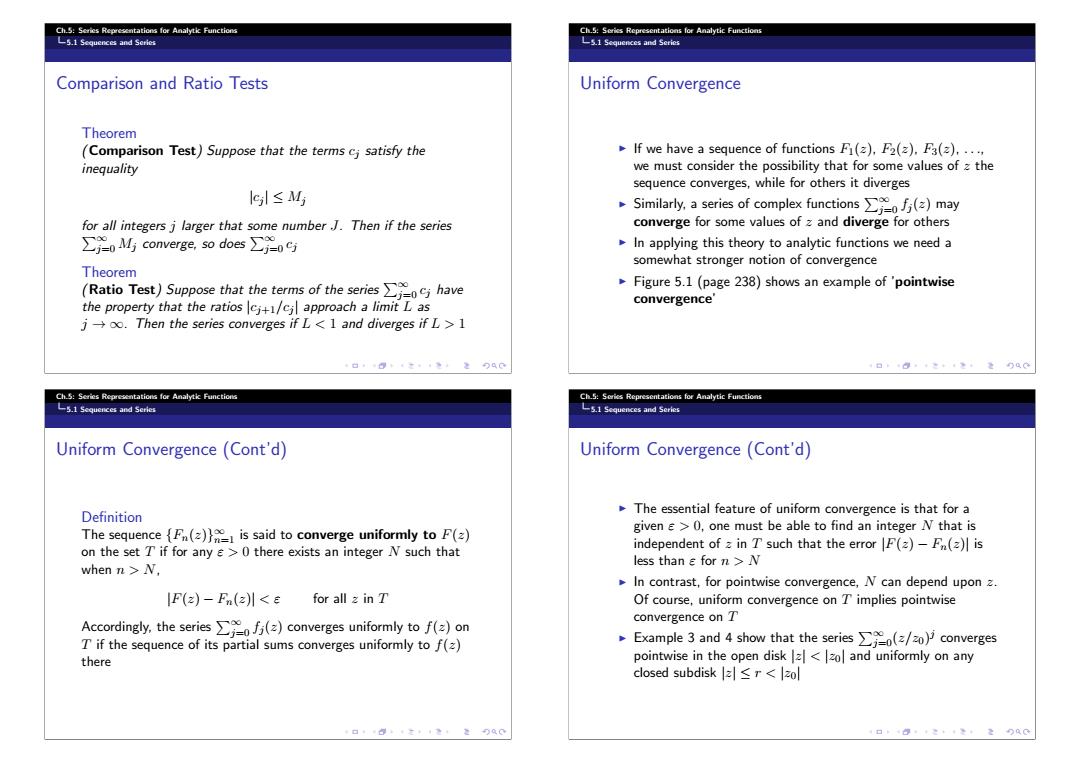正在加载图片...

Ch.5:Series Representations for Analyti Functions Ch.5:Series Representations for Analytic Functions 5.1 Sequences and Series L5.1 Sequences and Serics Comparison and Ratio Tests Uniform Convergence Theorem (Comparison Test)Suppose that the terms cj satisfy the If we have a sequence of functions Fi(z),F2(z).F3(z)...., inequality we must consider the possibility that for some values of z the sequence converges,while for others it diverges lS≤M Similarly,a series of complex functions()may for all integers j larger that some number J.Then if the series converge for some values of z and diverge for others ∑24 converge,so does∑=oS In applying this theory to analytic functions we need a somewhat stronger notion of convergence Theorem (Ratio Test)Suppose that the terms of the series have Figure 5.1 (page 238)shows an example of 'pointwise the property that the ratios cj+/cjl approach a limit L as convergence joo.Then the series converges if L<1 and diverges if L>1 Ch.5:Series Representations for Analyti Functions Ch.5:Scrics Representations for Analytic Functions L5.1 Sequences and Series 5.1 Sequences and Series Uniform Convergence(Cont'd) Uniform Convergence(Cont'd) Definition The essential feature of uniform convergence is that for a The sequence {Fn(z)is said to converge uniformly to F(z) given >0,one must be able to find an integer N that is on the set T if for any >0 there exists an integer N such that independent of z in T such that the error F(z)-Fn(z)is when n>N, less than e for n>N In contrast,for pointwise convergence,N can depend upon z. IF(2)-Fn(2)<E for all z in T Of course,uniform convergence on T implies pointwise Accordingly,the series()converges uniformly to f(z)on convergence on T T if the sequence of its partial sums converges uniformly to f(z) Example 3 and 4 show that the series (/z)converges there pointwise in the open disk z<zol and uniformly on any closed subdisk <r<zolCh.5: Series Representations for Analytic Functions 5.1 Sequences and Series Comparison and Ratio Tests Theorem (Comparison Test) Suppose that the terms cj satisfy the inequality |cj | ≤ Mj for all integers j larger that some number J. Then if the series ∞ j=0 Mj converge, so does ∞j=0 cj Theorem (Ratio Test) Suppose that the terms of the series ∞j=0 cj have the property that the ratios |cj+1/cj | approach a limit L as j → ∞. Then the series converges if L < 1 and diverges if L > 1 Ch.5: Series Representations for Analytic Functions 5.1 Sequences and Series Uniform Convergence If we have a sequence of functions F1(z), F2(z), F3(z), ..., we must consider the possibility that for some values of z the sequence converges, while for others it diverges Similarly, a series of complex functions ∞j=0 fj (z) may converge for some values of z and diverge for others In applying this theory to analytic functions we need a somewhat stronger notion of convergence Figure 5.1 (page 238) shows an example of ’pointwise convergence ’ Ch.5: Series Representations for Analytic Functions 5.1 Sequences and Series Uniform Convergence (Cont’d) Definition The sequence {Fn(z)}∞n=1 is said to converge uniformly to F(z) on the set T if for any ε > 0 there exists an integer N such that when n>N, |F(z) − Fn(z)| < ε for all z in T Accordingly, the series ∞j=0 fj (z) converges uniformly to f(z) on T if the sequence of its partial sums converges uniformly to f(z) there Ch.5: Series Representations for Analytic Functions 5.1 Sequences and Series Uniform Convergence (Cont’d) The essential feature of uniform convergence is that for a given ε > 0, one must be able to find an integer N that is independent of z in T such that the error |F(z) − Fn(z)| is less than ε for n>N In contrast, for pointwise convergence, N can depend upon z. Of course, uniform convergence on T implies pointwise convergence on T Example 3 and 4 show that the series ∞j=0(z/z0)j converges pointwise in the open disk |z| < |z0| and uniformly on any closed subdisk |z| ≤ r < |z0|�������������